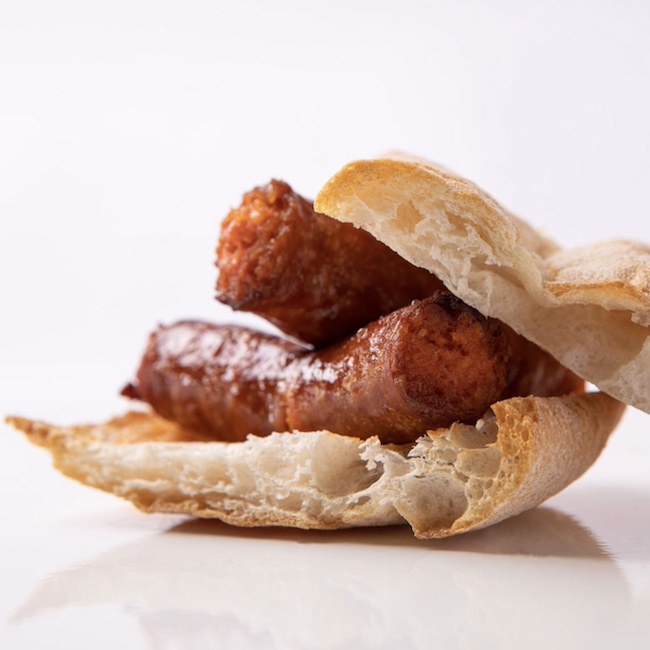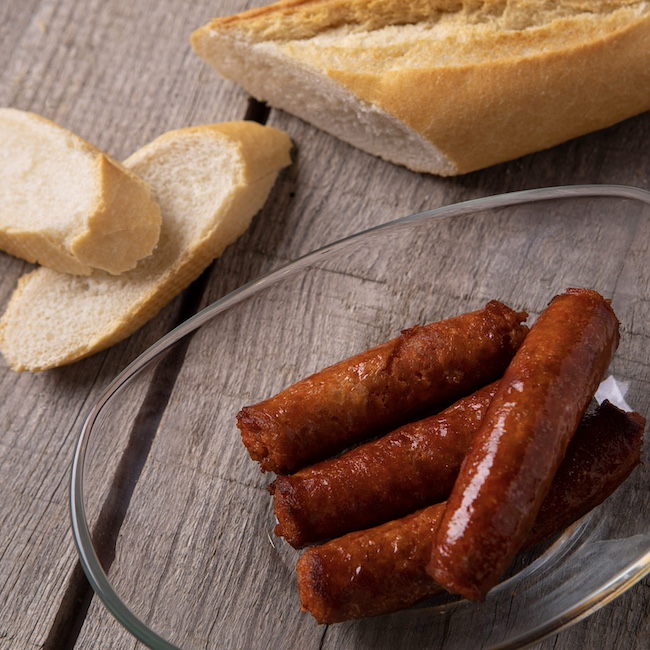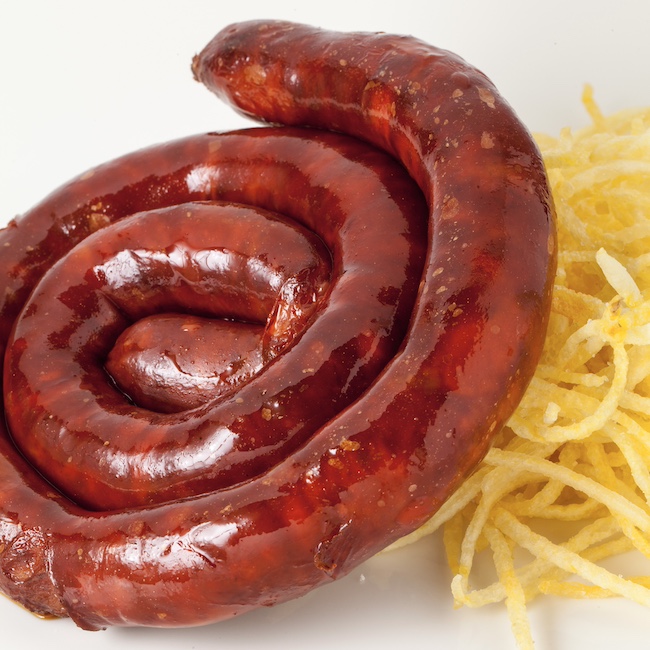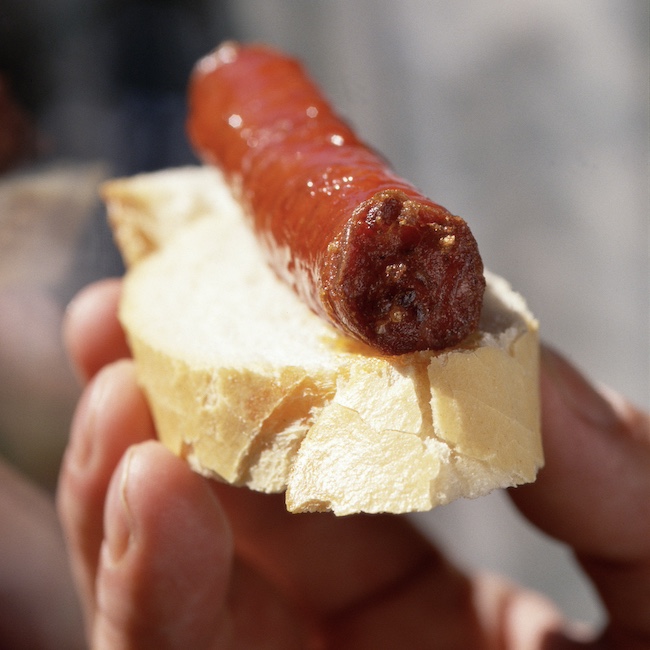by Javier Fernández Piera - @javierfpiera
.png.transform/rendition-xs/image_image%20(1).png)
This cured sausage, which has just been granted Protected Geographical Indication (PGI) status guaranteeing its origin, is irresistible as a tapa or as part of creative recipes

by Javier Fernández Piera - @javierfpiera
gastronomic emblem, it is undoubtedly chistorra. This sausage, encased in a delicate natural casing, encapsulates the essence of rustic kitchens, the crackling sound of wood-burning stoves, and the Spain that wakes up early in the cold and enjoys a hearty lunch. Spiced, juicy, and with the deep red hue of sweet pimentón that gives it its soul, chistorra has traveled a long road from family hog slaughters to international culinary recognition.
Chistorra stands out for its bold, intense flavor. When cooked, it releases a smoky and spiced aroma. Its texture is juicy and slightly crispy on the outside, while in the mouth, it melts, offering a perfect balance between rendered fat and meaty taste. The blend of spices and just the right amount of salt make it an irresistible bite.
Perhaps one of chistorra’s greatest charms is that it is always served in small pieces—ones you can never have just one of...

A Bit of History: The Soul of Navarra’s Matanza
Chistorra has its roots in the sausage-making tradition of Navarra. Since time immemorial, the slaughter of the pig (matanza) has been a key event in the rural family economy—a deeply rooted ritual where nothing went to waste. Due to its quick curing process, thanks to its natural casing made from the thin intestine of lamb, chistorra was often the first feast enjoyed after the slaughter.
More than just a simple sausage, it is a witness to history, to those kitchens with beams darkened by smoke, where chorizos and morcillas hung, and where txistor, as it is originally known in Navarra, carved out a place for itself among the embers and stovetops. Always consumed fresh, it became the first bite of the season—a kind of celebration of abundance and hard work well done.

Production: Simplicity and Authenticity
The secret to chistorra lies in the quality of its ingredients. Pork meat, selected in equal parts from lean and semi-fat cuts, is finely minced and mixed with seasoning. Here, each household’s recipe makes the difference: while it traditionally includes only salt, garlic, and sweet pimentón, the proportions or the addition of other spices are the key to success. The pimentón provides color and flavor, while garlic—if used in excess—can cause the sausage to harden over time. Some traditional recipes also incorporate a hint of oregano or thyme, depending on the region. The mixture is then stuffed into a thin natural casing, allowing for quick cooking and a juicy texture on the palate.
Navarra is home to producers who have preserved the essence of the product while incorporating modern techniques to ensure quality. Companies such as Embutidos Arbizu champion artisanal production with natural ingredients, achieving chistorras of exceptional flavor. As Embutidos Arbizu states, “Our commitment is to keep tradition alive, respecting the recipes of our ancestors and selecting the finest raw materials.”

Identity and Prestige: New PGI for Navarra’s Chistorra
Chistorra has recently been recognized with the Protected Geographical Indication (PGI) Chistorra de Navarra, a designation that reinforces its identity and prestige within the Spanish and international meat industry. This new PGI certification ensures the quality and authenticity of chistorra produced in Navarra, guaranteeing that it meets the highest standards in production and ingredients.
Because chistorra has already conquered international markets. In countries like France—the main importer (80% of exports)—but also Mexico and the United States (20%), this sausage has found its place in the kitchen, especially in the vacuum-packed version produced by major meat exporters: Navarra de Embutidos, Argal, Goikoa, and Galar. Aforementioned Embutidos Arbizu also exports to countries as United Kingdom, France, Norway, Switzerland, Philippines and different countries in South America.
In Europe and Latin America, its flavor and versatility have made it an ideal addition to classic barbecues and the preparation of traditional Spanish tapas, which is why consumption increases significantly during the summer months in both hemispheres.

Versatility in the Kitchen
This sausage is not only enjoyed on its own but also features in countless traditional and contemporary recipes. From the classic “Navarra-style breakfast”, where it is served with bread and wine, to innovative dishes in haute cuisine, including traditional recipes with broad beans or white beans.
Renowned chefs like Juan Mari Arzak have incorporated chistorra into sophisticated creations, such as “crispy chistorra with potato foam”, a modern reinterpretation of a Basque-Navarrese classic. Other examples include its use even in croquetas, offering a surprising twist on traditional recipes. In everyday restaurants, it is commonly found alongside fried eggs or huevos rotos. And when served in a sandwich, between slices of bread, it becomes one of the most delicious delicacies.
It’s not uncommon for a restaurant—what the Catalan writer Manuel Vázquez Montalbán, who wrote several books about Spanish Gastronomy that have became classics, called “fetén” (top-notch)—to offer a few slices of chistorra as an appetizer.
Some claim that the Duelos y Quebrantos recipe mentioned in Don Quixote contains chistorra, though others argue that it is a thicker sausage rather than the delicate Navarrese txistor. In any case, reimagine classic recipes like tortilla, lentils, stewed potatoes as patatas a la riojana, with pulpo (why not?)… all with chistorra, and you'll achieve not only real refinement, but also a special flavor.
A Favorite in “Restaurants from Spain”
Chistorra has already conquered international markets. In countries such as France, Mexico, and the United States, this sausage has found its place in local cuisine, especially in vacuum-sealed versions that ensure its freshness. In Latin America, its flavor and versatility have made it an ideal addition to barbecues and classic Spanish tapas.
It holds a prominent spot on the menus of many Restaurants from Spain, establishments certified for offering authentic, high-quality Spanish cuisine. Some notable restaurants featuring it on their menus include Matiz in Panama City (Panama) and La Lluna de Valencia in San Pedro de Barva (Costa Rica). It is also available for purchase, ready to cook, at stores from Spain like CanDisPro in Ancaster (Canada) and Brindisa in London (United Kingdom).
Conclusion: A Gastronomic Icon
Navarra’s chistorra is much more than just a sausage—it is history, tradition, and pure flavor. A symbol of identity that has withstood the test of time and changing culinary trends, maintaining its essence while winning over palates across the world. Because wherever there is a glowing ember, a glass of wine, and a good conversation, chistorra will be there—both as a witness and a protagonist of the finest Spanish gastronomy.